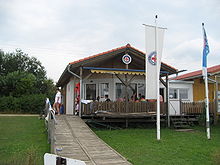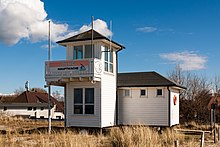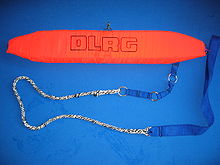Water rescue station
A water rescue station , also called a rescue station , is a facility of an organization active in the water rescue service, such as the German Life Rescue Society (DLRG), the Arbeiter-Samariter-Bund (ASB) or the water rescue service . The station is located near the bodies of water to be guarded and serves the emergency services of the operating organization as a place of residence, headquarters and guard. There are water rescue stations in many different designs, including the large, well-developed guards on the coasts of the North and Baltic Seas and on larger rivers or lakes, but also guards that only consist of a caravan or a hut. These are mostly located on smaller inland waters.
tasks
A water rescue station is always responsible for monitoring the water in its area of responsibility. In emergencies, first and general aid (e.g. rescue, general help for water sports enthusiasts and rescue) is to be provided. The area of responsibility of the station is usually a bathing lake or a river or beach section from 100 m to 20 km in length.
If it is a larger station with up to 40 emergency services and attached towers, the coordination of service operations in the surveillance area is another important task. This includes that from the station, the emergency services in the entire guard area are divided into the various positions (watchtowers, boats, patrols) and z. B. Motor lifeboats and divers are sent into action. In addition, the station is always the main point of contact for the emergency services in the water rescue service in the event of problems and questions and monitors and directs all radio calls (star radio) of the emergency services in the water rescue service in their area.
In the event of an emergency, the water rescue station also notifies the police , rescue services and other emergency services required. In addition, the entire documentation of operations is carried out (e.g. boat and radio diary, operational reports). In bad weather conditions, emergency services that are not required can be trained in the station.
Equipment and location
The equipment of water rescue stations is very different nationwide. It is based on local conditions and the financial resources available.
When it comes to the financial resources of a water rescue station, the size and requirements of the area of operation play a role. The larger or more demanding the area to be monitored, the more material and therefore money the station needs. The legal requirements (e.g. bathing facilities ordinance, statutes) are important here, as these, such as B. in Schleswig-Holstein, prescribe a minimum equipment. Another important factor is your own financial resources, i.e. donations from the organization that operates the station. Often the organizations or branches on site also receive grants within the framework of state rescue laws and / or state disaster protection laws as well as grants from the public sector (e.g. development associations, donations). This very different distribution of financial resources means that there are, on the one hand, very well-developed, modern stations and, on the other hand, very old stations that only consist of a hut, a construction container or caravan, etc.
In addition to the equipment, the location of the station is also important. So that the lifeguards have a good overview, the station is usually close to the body of water for which it is responsible. If different watchtowers are attached to the station in a large guard area, the station is often in the middle in order to be able to support all units quickly. For the further care of the accident victims, it is necessary that the station can be easily reached by ambulance or, in the case of serious injuries, even by helicopter.
Minimal equipment
For the smooth operation of a water rescue station, a station must be equipped with stationary operating radios and handheld radios in order to be able to communicate and coordinate operations with all units in the guard area. Depending on the requirement profile, BOS radios are required to communicate directly with an ambulance or the rescue control center. In certain guarded areas, inland navigation and marine radio equipment are also required to exchange information with ships (e.g. DGzRS ). A special permit must be available for fixed stations. Furthermore, a radio is necessary for the weather report and warnings so that the lifeguards know in good time whether they have to prepare for heavy seas or a thunderstorm, for example. A telephone to make emergency calls is essential. Binoculars are required so that the lifeguards can watch the water and what is happening far from the station.
In order to be able to understand the operations and what happened in the guard area later, a water rescue station has to keep and fill out various forms such as service and operation reports (e.g. radio diary). First aid equipment , rescue equipment, water life-saving equipment , boats and vehicles (depending on the guard area) are still required in the event of an emergency .
Additional equipment
Depending on the training of the staff, additional material may also be available, for example an emergency case , a vacuum mattress or an automated external defibrillator (AED) . According to GUV rule 2101, a rescue company must also provide the option of ventilation with oxygen when using divers .
Rescue equipment
At the station and the watchtowers there are usually various rescue devices to protect the lifeguards when they are out in the water. Ideally, all lifeguards who are on duty at the station know the storage locations and how to use the rescue equipment listed. A water rescue station usually has one or more of these devices so that the lifeguards can choose the right one for every type of operation.
In addition, every lifeguard should have his ABC equipment (mask, snorkel, fins) with him and ready to use in order to be able to provide help even more effectively. Many lifeguards also have wetsuits , e.g. E.g. when searching in the water for longer periods of time without hypothermia or to be able to swim in polluted water (e.g. blue-green algae ).
Emergency vehicles

In addition to the rescue equipment mentioned, a water rescue station can also be equipped with boats or vehicles.
Many water rescue stations have one or more lifeboats with and without a motor in order to get the lifeguards out into the water to the casualty quickly and with little risk to themselves and to be able to take care of them while on the water. At some stations there is also a rescue jet ski with sledges for the injured. This serves the same purpose as the lifeboat, but is usually even faster.
If a water rescue station is responsible for a larger guarded area, it can be equipped with emergency vehicles for various purposes. At stations with great distances between the watchtowers, there are often emergency bicycles so that the lifeguards can support each other quickly or get to an accident victim quickly.
construction

Depending on the size and area of responsibility, a water rescue station can contain several rooms and areas. Smaller guards only consist of a guard, medical and equipment room. Very small guards can also consist of just one guard room.
The guard room
The guard room is the main area of the water rescue station. From here, the lifeguards watch the water and thus ensure the safety of bathers. In many cases, the guard room is also the radio room at the same time, so that all information from the guard area and, depending on the radio equipment, from beyond come together in it. The head of the watch coordinates the operations from here and organizes the security service.
If the water rescue station has a boat or vehicle, the boat crew is usually also in the guard room so that they can intervene immediately in the event of an emergency.
other rooms
Larger guards, who can mainly be found on the coasts of the North Sea and Baltic Sea , can have their own radio room and / or a watch director's office in addition to the rooms mentioned above, which are spatially separated from the guard room. Often you will also find kitchen, bedrooms and sanitary rooms there, as these water rescue stations are often the accommodation of the lifeguards for the duration of their stay. For smaller and larger repairs to the material used, some stations also have a workshop and, if necessary, garages for vehicles.
staff
A water rescue station is staffed as follows, depending on the weather, personnel, area of responsibility and size:
She always needs a head guard and a deputy. If the water rescue station has a lifeboat or lifeboat, the boat driver / driver and the respective crew should be present. If available, a rescue diving team can also be present at the station. A radiotelephone operator is always present at larger stations with their own radio room. On smaller wards, this task is usually carried out by the guard. The majority of the employees at a water rescue station are the lifeguards .
Responsibilities and authority to issue instructions
- The head of the watch is authorized to give instructions to all units of a water rescue station. In individual cases, the head of the watch can be replaced by a head of the water rescue team (EL WR). He is a guarantor within the scope of the activity in the water rescue service ( guarantor obligation ). He is the representative of the water rescue organization and host in the water rescue station and is responsible for the underage lifeguards or water rescuers who are on duty . Among other things, he is responsible for the division of staff, the organization of the service process and the material.
- The coxswain is responsible for his assigned motor lifeboat and its crew (boat person). He has to follow the instructions of the watch leader as long as there is no danger to the boat and crew. In the event of an emergency, he provides help with his boat quickly and with little risk to the emergency services.
- The dive leader (TaEF) is responsible for one or more diving teams. He alone makes the decisions about the diving mission and its implementation and is only subordinate to the head of the watch or the head of operations. However, every mission diver decides for himself whether he is available for diving.
- Lifeguards make up the majority of the staff. The task of the lifeguards deployed is to protect bathers from dangers through education and prevention. They provide help in emergencies in and around the water and look after people in need and the injured. They are not authorized to give instructions to third parties (bathers) and are subordinate to the guard.
Service operation
The water rescue stations on the North Sea and Baltic Sea are manned seven days a week from 9 a.m. to 6 p.m. during the main season. Water rescue stations at inland lakes, swimming pools or rivers are often only manned on weekends or at certain times, because the members of the local operating group have to work themselves during the week. However, some of these stations are also manned in winter in order to ensure the safety of winter sports enthusiasts when the lakes are frozen, etc. The service operation is similar on all stations. The service begins with the raising of the flag of the respective organization (DLRG eagle, watermark) and the red and yellow flag, which makes it clear that the water rescue station is manned and ready for use. For stations that have not yet implemented the international labeling system, this can only be the respective symbol. In the case of larger wards with external towers, there is usually a service meeting at which the individual posts are distributed. Then the towers are occupied and the flags are also hoisted there. At stations with boats or other watercraft, the crews lower them into the water or fetch them from the port. If a tower or vehicle is ready for use, the crew reports to the main guard as being ready for use.
During duty, the main guard coordinates the activities of the emergency services in the guard area via radio or telephone; that is, she sends lifeguards on patrol or as reinforcement to another tower or coordinates the activities of the boats and divers. The individual emergency services spend most of the day on their wards and rarely leave them to eat, patrol the water or provide help (first aid, rescue, etc.).
At the end of duty, the watercraft are brought back to port or on land and the flags are raised to show that the station is no longer operational. The individual towers report to the main guard as no longer ready for use. The service ends with a service meeting in which the events of the day are processed and the operations are analyzed.
Watchtowers
Watchtowers are often attached to a water rescue station . Since a water rescue station usually has to monitor a large area of several kilometers, but cannot possibly monitor the entire section from one point, there are watch towers at regular intervals from the main station.
These are usually elevated, close to the water and have up to three or more lifeguards, depending on their size. They are usually equipped with water life-saving equipment and first aid equipment. The lifeguards quickly go to work from there and treat minor first aid cases directly at the tower. You are connected to the main station via radio and / or telephone so that help can be requested quickly in the event of major accidents. Depending on what has been agreed with the main guard, the lifeguards can also go to work autonomously from the watchtower.
Flags
In order to provide bathers and beach visitors from far away with the most important information about the water, flags are set at many water rescue stations and associated watchtowers. Many water rescue organizations use a uniform labeling system that has been standardized by the ISO since 2008 . After this, a marked bathing area, which is guarded by lifeguards, is signaled by hoisting a red and yellow water rescue flag. In addition, a club flag (e.g. the DLRG eagle or the watermark) can be hoisted. If the yellow-red flag is placed directly on the water, it limits the bathing area. The above flags and an additional pure yellow flag indicate that bathing and swimming is dangerous and swimming is prohibited for inexperienced swimmers, children and the elderly. Bathing and swimming generally prohibited is indicated by a pure red flag. All other flags can be brought in here for clarity. A position flag quartered in black and white reveals a section of the beach for use with water sports equipment (jet skis, etc.). Swimming is prohibited here.
In order to make beach visitors and swimmers directly aware of a danger or to give them information (e.g. missing person report, danger), the lifeguards also use the whistle to attract attention or the megaphone to take them over long distances, for example Boot to communicate. On some beaches in the North and Baltic Seas, there is also a loudspeaker system that can be used to sound the entire beach.
history
The first European water rescue station began its service in Amsterdam in 1767. Just one year later, in 1768, the first German water rescue station was put into operation by the Hamburg Society for the Rescue of Drowned People in Hamburg. Little by little, more stations were set up in Germany, especially after the founding of the water rescue service in 1883 and the German Life-Saving Society in 1913, more and more stations were set up on German inland waters and on the coast.
numbers
The DLRG operates around 1,050 permanent and around 700 mobile water rescue stations in Germany.
The water rescue service operates 2,260 stations in Bavaria alone, including:
- 358 at lakes
- 88 in rivers and other locations
- 1814 in indoor and outdoor pools
literature
- Peter A. Fischer, Thilo Künneth, Alfons Vorderauer: Pocket book for water rescuers. Basics for training and practice . Published by the Deutsche Lebens-Rettungs-Gesellschaft e. V. - Presidium. ecomed verlagsgesellschaft AG & Co. KG, Landsberg / Lech 2003, ISBN 3-609-68779-7 .
swell
- ↑ ISO 20712: 2008 Water safety signs and beach safety flags ( online )
- ^ Presidium of the DLRG Status: 2005
- ↑ Statistics from Wasserwacht Bayern ( page no longer available , search in web archives ) Info: The link was automatically marked as defective. Please check the link according to the instructions and then remove this notice. Status: 2009














